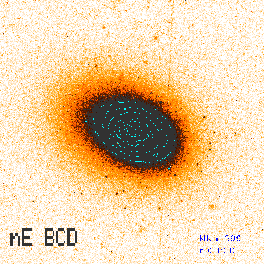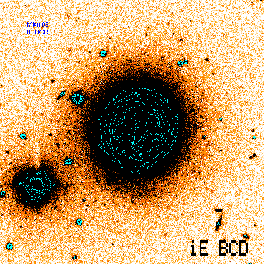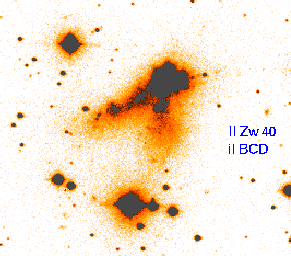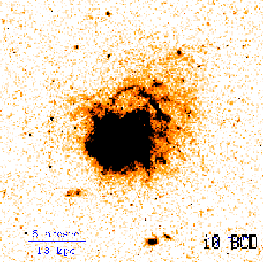Optical
studies of Blue Compact Dwarf Galaxies with the 1.23m telescope
 P.
Papaderos, K.G. Noeske, K.J. Fricke
P.
Papaderos, K.G. Noeske, K.J. Fricke
Universitäts
Sternwarte, Geismarlandstraße 11, 37083 Göttingen, Germany

Blue
Compact Dwarf Galaxies (BCDs) are low-luminosity (MB>-18 mag), gas-rich
extragalactic systems
undergoing
intense star formation (SF) activity (cf. e.g. Thuan & Martin 1981,
hereafter TM81). A first deep
optical
survey of such systems (Loose & Thuan 1985) revealed in the vast majority
of them an evolved (few Gyr)
stellar
low-surface-brightness (LSB) component underlying the regions of active
star formation.
This
finding went a long way in deciding the fundamental problem whether BCDs
are young systems in their formation
process
or whether these objects form a class of gas-rich old dwarf galaxies undergoing
episodes of strongly enhanced
SF
activity (starbursts). On statistical grounds these are separated by longer
quiescent phases (Thuan 1991).
The
Loose & Thuan imaging survey has furthermore demonstrated the morphological
heterogeneity of BCDs and
resulted
in the development of the first empirical classification scheme for these
systems (cf. Fig. 1).
Fig.
1: The four main morphological subdivisions of BCDs in the
classification scheme by Loose & Thuan (1985).
Systems belonging to the nE and iE type comprise roughly
90% of the local BCD population; they exhibit a nuclear
or irregular high-surface-brightness SF component on top a smooth elliptical/circular
LSB host. In BCDs classified
iI both the starburst and the LSB component are of irregular morphology.
In BCDs belonging to the rare i0 type a
regular stellar LSB host is virtually absent. Extremely metal deficient
members of this class are thought to be promising
candidates of young galaxies.
A
central question to recent BCD studies concerns the origin of their recurrent
starburst activity. Most BCDs
are
known to be isolated with a fraction of them being arranged in loose groups
close to void boundaries
(e.g.
Campos-Aguilar & Moles 1991, Pustil'nik et al. 1995, Lindner et al.
1996, Popescu et al. 1999).
Dynamical
interactions or merging with luminous companions are therefore not likely
to be the generic
triggering
agent for their starburst activity. Interaction with or accretion of a
low-mass gaseous companion
offers
a viable hypothesis which has motivated a number of recent interferometric
studies of BCDs
(e.g.
Taylor et al. 1993,1995). Alternatively, the transient starburst phenomenon
in BCDs may be accounted
for
by intrinsic processes, such as stochastic self-propagating SF (Gerola
et al.1980), cloud-cloud collisions
or a cyclic process of gas
infall from and expulsion into the halo.
Particularly
the last-mentioned scenario calls for an investigation of the role of the
older LSB stellar component
on
the galaxy-wide SF process. While the LSB host contributes on average only
one half of the B band luminosity
of
a BCD within its 25 B mag arcsec-2 isophotal radius (Papaderos
et al. 1996, Salzer & Norton 1998), it provides
due
to its high M/L ratio the bulk of the stellar mass in the galaxy. If, therefore,
dark matter does not dominate entirely
the
mass of a BCD within its optical size, the stellar LSB host may strongly
determine the gravitational potential within
which
starburst activity takes place. Indeed, a recent study by Papaderos et
al. (1996) provides circumstantial evidence
for
a connection between the SF activity in BCDs and the physical properties
of their LSB hosts and requires a thorough
investigation
of this issue with larger BCD samples.
Surface
photometry, i.e. measuring the photometric structure and colors of LSB
component, is an essential tool here
and
became an important piece of evidence in recent studies of such systems
(Marlowe et al. 1997, Doublier et al. 1997;1999,
Telles et al. 1997, Smoker
et al. 1999, Makarova et al. 1999, Vennik et al. 2000, Cairos et al. 2000).
Despite
the significant progress made in the field in the past few years, a continuation
of surface photometry studies
appears
necessary for drawing firm conclusions on the build-up and evolutionary
status of BCDs over their wide
morphological
spectrum and exploring possible evolutionary links between them and other
species of the dwarf galaxy
population
(e.g. dwarf irregulars or dwarf ellipticals). In continuation of previous
studies of BCDs (Papaderos et al. 1996,
Noeske et al. 2000) we
recently started a broad-band imaging survey of such systems with the upgraded
1.23m telescope
at Calar Alto (see
Calar
Alto Newsletter N.1 January 2000). Our aim is to derive surface brightness
and colour profiles of
roughly 40 nearby BCDs
out to their Holmberg radius and infer therefrom the structural properties
and age of their stellar LSB
hosts. In an initial stage
of this campaign we observed in February 2000 a subset of 20 sample galaxies
compiled from the
TM81
list. The telescope was equipped with a 2k SITe CCD detector yielding an
instrumental scale of 0.5 arcsec pixel-1
and
a usable field of view of ~11 arcmin in diameter. The typical sky background
during the observations was
~22.2
B mag arcsec-2. Exposures were taken in B and R and have been
splitted into at least two sub-exposures with
integration
times ranging typically between ~15 and 30 min.
Here
we shall briefly comment on the performance of the telescope after its
recent upgrade regarding the capabilities
it
offers for surface photometry studies. For this purpose we discuss next
the surface brightness distribution of one of
the
sample galaxies, Mkn 178, as derived from a 28 min sub-exposure in the
B band. For a detailed review of the
spectrophotometric
properties of this Wolf-Rayet galaxy the reader is referred to e.g. Zamorano
& Rego (1986),
Gonzalez-Riestra
et al. (1988), Conti 1991 and Guseva et al. 2000. An elaborated study of
the stellar content of the
starburst
component of Mkn 178 based on HST/NICMOS colour-magnitude diagrams has
been recently accomplished by
Schulte-Ladbeck
et al. (2000).
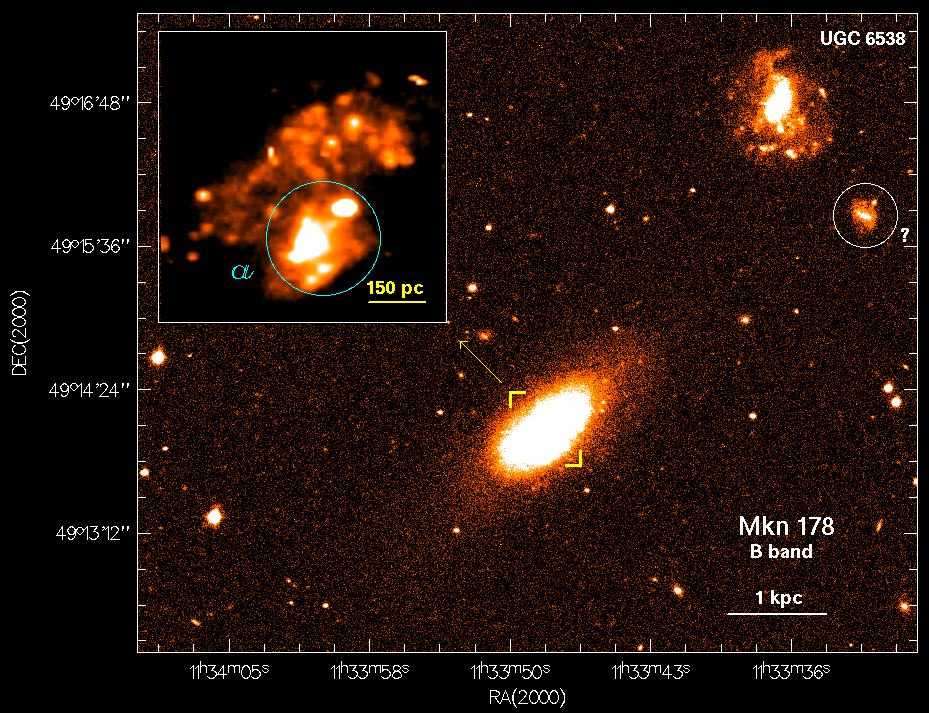
Fig.
2: B band exposure
of the iE BCD Mkn 178 (D=4.2 Mpc; cf. Schulte-Ladbeck et al. 2000) taken
with the Calar Alto 1.23m telescope.
The integration time was 28 min
and the seeing 1.05 arcsec (FWHM). Note the complex morphology of the high-surface-brightness
region
northeast of the main starburst
region comprising an assembly of faint compact sources with a typical absolute
B magnitude of -7.5 mag.
The dominant starburst source
a
(MB~
-12 mag) contributes ~40% of B band emission in excess of the LSB host
(cf. Fig. 3).
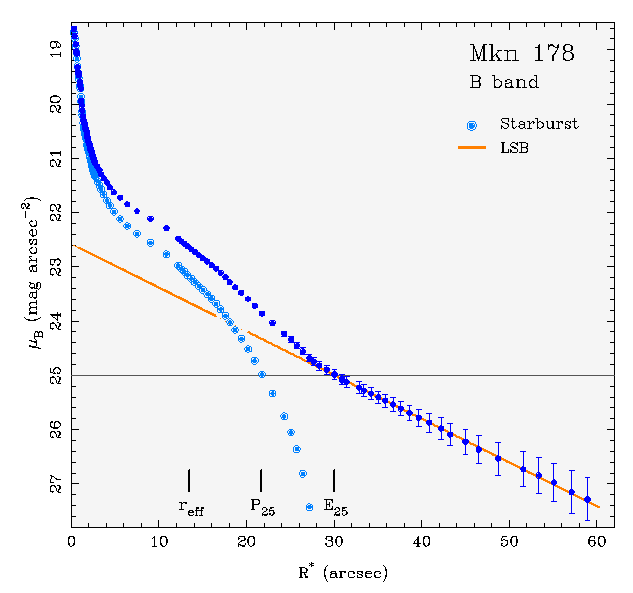
Fig.
3: Decomposition of the surface brightness profile of Mkn
178 in the B band in an exponential component
approximating the intensity distribution of the LSB host (thick
line) and the starburst emission in excess of the
former (open circles). The profile
is corrected for Galactic extinction (AB=0.08 mag). The effective
radius reff
as well as the isophotal radii of the starburst P25 and of the
LSB host E25 at 25 B mag arcsec-2are indicated.
The
surface brightness profile of Mkn 178 (Fig.
3) is typical of an iE BCD comprising three marked intensity
regimes:
a
compact intensity excess at small radii , an extended plateau-like feature
at intermediate radii and an exponential
intensity
decrease in the outskirts of the BCD dominating the light for a surface
brightness level fainter than ~25
mag
arcsec-2. The first two components are mainly due to the luminosity
output of the young stellar content whereas
the
last one originates from the old underlying LSB host. A simple decomposition
of the SBP shows that the starburst
contributes
within the 25 mag arcsec-2 isophotal radius (E25)
~60% of the B band emission. Its line-of-sight contribution
decreases
monotonously with increasing equivalent radius R* from ~90% at the center
to ~60% at its effective radius and
getting
negligible beyond E25. The decreasing contribution of the starburst
component in Mkn 178 shows up also in the
gradual increase of its B-R
colour index from ~0.6 mag at the effective radius reff to ~1.1
mag for R*>E25.
From
Fig. 3 is evident that an integration of ~30 min allows to trace the intensity
distribution of the stellar LSB host down
to
a surface brightness level fainter than 26.5 B mag arcsec-2.
This shows that the upgraded 1.23m telescope offers an
interesting
option for pursuing an extensive photometric study of nearby starburst
galaxies at a reasonable expense of
observing time.
From
the deep surface photometry for a large number of BCDs we are currently
deriving the structural properties
(central
surface brightness, exponential scale length, colour gradient) of their
LSB hosts and shall discuss them
together
with the photometric structure of other dwarf galaxy types (e.g. dwarf
irregulars, dwarf ellipticals) in order to
test
scenarios for evolutionary connections and to detect clues to the origin
of the BCD phenomenon.
Such
an investigation will refine earlier results obtained by us (Papaderos
et al. 1996).
Cairos,
L.M., Vilchez, J.M. et al. 2000, ApJ submitted
Campos-Aguilar,
A., Moles, M. 1991, A&A 241, 358
Conti,
P.S. 1991, ApJ 377, 115
Doublier,
V., Comte, G., Petrosian, A. Et al. 1997, A&AS 124, 405
Doublier,
V., Caulet, A., Comte, G. 1999, A&AS 138, 213
Gerola,
H., Seiden, P.E., Schulman, L.S. 1980, ApJ 242, 517
Gonzalez-Riestra,
R., Rego, M., Zamorano, J. 1988, A&A 202, 27
Guseva,
N.G., Izotov, Y.I., Thuan, T.X. 2000, ApJ 531, 776
Lindner,
U., Einasto, M., Einasto, J., Fricke, K.J., Lipovetsky, V.A. Et al. 1996,
A&A 314, 1
Loose,
H.-H., Thuan, T.X. 1985, in Star-Forming Dwarf Galaxies, eds. D. Kunth,
T.X. Thuan & J.T.T. Van, Editions Frontieres, p. 73
Makarova,
L. 2000, A&AS 139, 491
Marlowe,
A.T., Meurer, G.R., Heckman, T.M., Schommer, R. 1997, ApJS 112, 285
Noeske,
K.G., Guseva, N.G., Fricke, K.J. et al. 2000, A&A in press
Papaderos,
P., Loose, H.-H., Fricke, K.J., Thuan, T.X. 1996, A&A 314, 59
Popescu,
C.C., Hopp, U., Rosa, M.R. 1999, A&A 350, 414
Pustilnik,
S., Ugryumov, A.V., Lipovetsky, V. A., Thuan, T.X., Guseva, N.G. 1995,
ApJ 443, 499
Salzer,
J.J., Norton, S.A. 1998, IAU Colloquium 171: The Low Surface Brightness
Universe, astro-ph/9810338
Schulte-Ladbeck,
R.E., Hopp, U., Greggio, L., Crone, M.M. 2000, AJ in press, astro-ph/0007417
Smoker,
J.V., Axon, D.J., Davies, R.D. 1999, A&A 341, 725
Taylor,
C., L., Brinks, E., Skillman, E.D. 1993, AJ 105, 128
Taylor,
C.L., Brinks, E., Grashuis, R.M., Skillman, E.D. 1995, ApJS 99, 427
Telles,
E., Melnick, J., Terlevich, R. 1997, MNRAS 288, 78
Thuan,
T.X., Martin, G.E. 1981, ApJ 247, 823
Thuan,
T.X. 1991, in Massive Stars in Starbursts, eds. C. Leitherer et al. , Cambridge
University Press, p. 183
Vennik,
J., Hopp, U., Popescu, C.C. 2000, A&AS 142, 399
Zamorano,
J., Rego, M. 1986, A&A 170, 31
 P.
Papaderos, K.G. Noeske, K.J. Fricke
P.
Papaderos, K.G. Noeske, K.J. Fricke P.
Papaderos, K.G. Noeske, K.J. Fricke
P.
Papaderos, K.G. Noeske, K.J. Fricke![]()
